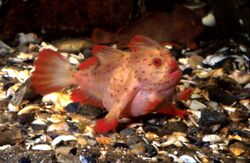Biology:Red handfish
| Red handfish | |
|---|---|

| |
| Scientific classification | |
| Domain: | Eukaryota |
| Kingdom: | Animalia |
| Phylum: | Chordata |
| Class: | Actinopterygii |
| Order: | Lophiiformes |
| Family: | Brachionichthyidae |
| Genus: | Thymichthys |
| Species: | T. politus
|
| Binomial name | |
| Thymichthys politus (Richardson, 1844)
| |
The red handfish (Thymichthys politus, formerly Brachionichthys politus[2]) is a species of handfish in the genus Thymichthys, found in Frederick Henry Bay, Tasmania.[2]
Description
The red handfish is distinguished by its small, flattened wart-like protuberances that cover its body and red colouration. Two colour morphs exist, a bright red morph with red colour on both body and fins, with a black line separating the white fin edges and a mottled morph with pink body covered in many red patches, with translucent pink fins expressing some bright red patches. They measure an average standard length of 61.4 mm (2.4 in) and an average total length of 80.1 mm (3.2 in).[2] They use their hand-like fins to crawl rather than swim.[3]
Ecology and behavior
Distribution and habitat
Historically, the species was found in multiple subpopulations in Tasmania, including Port Arthur, Fortescue Bay, the Actaeon Islands, D'Entrecasteaux Channel, and the Forestier Peninsula. Currently, the species has been found only on two small reefs in Frederick Henry Bay. These species typically reside in reef sand junctions, where there is an abundance of sand and rocks. The macro-algae that covers the rock allows them to easily blend in with their environment. These reefs measure no more than 50 m in diameter with a circular area of no more than 75 m. It is found at depth ranges from 1 m up to 20 m.[2]
Reproduction
Their limited range is attributed to the low reproduction and dispersal rate. Unlike other fish they recruit directly on the benthos.[4] Females lay their eggs at the base of seagrass from august through to October. Each egg mass contains 30- 60 eggs that are connected by tubules bound together. These eggs are then guarded by the adults until they hatch.[5]
Diet
Little is known about their diet but that it consists of animals that live in the benthos. Their diet consists of small crustaceans and polychaete worms.[6]
Conservation
In November 2023, researchers at Tasmania’s Institute for Marine and Antarctic Studies (IMAS) found a cluster of 21 yellow eggs in one of their tanks for red handfish. One of the researchers said “We’re delighted to announce the safe arrival of 21 baby red handfish.” This is the second time red handfish have been breed in captivity, with the previous time being in 2021.[7]
Threats
General threats to red handfish include small, very fragmented populations and local increases in density of native purple urchins. Native purple urchins overgraze the seaweed habitat required for shelter and spawning for the red handfish. Summer observations of low seaweed on urchin barrens suggest that loss of seaweed habitat might represent a key threat to long term viability of the population In addition, the close vicinity of urban development increases the risk of nutrient runoff, pollution, siltation, and turbidity. This results in habitat degradation through the ruin of the red handfish preferred seaweed habitat. Loss of spawning substrate limit the red handfish as to where their eggs can attach resulting in the eggs being lost to the current. Limitations include difficulty spotting the species among its habitat. Red handfish may face severe pressure due to direct environmental consequences of warming coastal waters, including potential implications on reproduction, egg development, feeding, and escape reaction, which are currently unknown.
Status
The red handfish is classed as Critically Endangered under the Australian Environment Protection and Biodiversity Conservation Act 1999 (EPBC Act) and by the IUCN, and as Endangered under Tasmania's Threatened Species Protection Act 1995.[4]
References
- ↑ Stuart-Smith, R.; Edgar, G.; Last, P.R. (2020). "Thymichthys politus". The IUCN Red List of Threatened Species (IUCN) 2020: e.T123423510A123424379. doi:10.2305/IUCN.UK.2020-1.RLTS.T123423510A123424379.en. Listed as Critically Endangered (CR B1ab+2ab;C2a)
- ↑ 2.0 2.1 2.2 2.3 Last, P.R.; Gledhill, D.C (2009). "A revision of the Australian handfishes (Lophiiformes: Brachionichthyidae), with descriptions of three new genera and nine new species.". Zootaxa (Magnolia Press) 2252 (1): 1–77. doi:10.11646/zootaxa.2252.1.
- ↑ Jeffery, Michael I.; Firestone, Jeremy; Bubna-Litic, Karen, eds. (2008), "Sanctuaries, Protected Species, and Politics – How Effective Is Australia at Protecting Its Marine Biodiversity under the Environment Protection and Biodiversity Conservation Act 1999?", Biodiversity Conservation, Law + Livelihoods (Cambridge: Cambridge University Press): pp. 280–305, doi:10.1017/cbo9780511551161.018, ISBN 9780511551161, http://dx.doi.org/10.1017/cbo9780511551161.018, retrieved 2023-04-12
- ↑ 4.0 4.1 The PLOS ONE Staff (2018-09-26). "Correction: Local densities and habitat preference of the critically endangered spotted handfish (Brachionichthys hirsutus): Large scale field trial of GPS parameterised underwater visual census and diver attached camera". PLOS ONE 13 (9): e0205040. doi:10.1371/journal.pone.0205040. ISSN 1932-6203. PMID 30256847.
- ↑ Jeffery, Michael I.; Firestone, Jeremy; Bubna-Litic, Karen, eds. (2008), "Sanctuaries, Protected Species, and Politics – How Effective Is Australia at Protecting Its Marine Biodiversity under the Environment Protection and Biodiversity Conservation Act 1999?", Biodiversity Conservation, Law + Livelihoods (Cambridge: Cambridge University Press): pp. 280–305, doi:10.1017/cbo9780511551161.018, ISBN 9780511551161, http://dx.doi.org/10.1017/cbo9780511551161.018, retrieved 2023-04-12
- ↑ "Tasmania (Australia), Bass Strait Coast". Journal of Coastal Research 100 (sp2). 2022-12-31. doi:10.2112/jcr-si100-flat-058.1. ISSN 0749-0208. http://dx.doi.org/10.2112/jcr-si100-flat-058.1.
- ↑ "Researchers Look In Tank And See Promising Cluster Of Nearly-Extinct Babies - The Dodo". https://www.thedodo.com/amphtml/daily-dodo/researchers-look-in-tank-and-see-promising-cluster-of-nearly-extinct-babies.
These sources are from the science citation index. Specifically, they were found through the University of Illinois at Chicago database.
Wikidata ☰ {{{from}}} entry
 |


